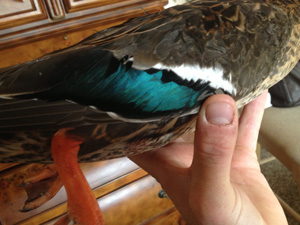 |
||
| Common name: |
Mexican Duck, |
|
| Scientific name: | Anas (platyrhynchos) diazi or hybrid | |
| Date: | 1 or 2 November 2013 | |
| Time: | ? | |
| Length of time observed: | Harvested | |
| Number: | 1 | |
| Age: | Adult | |
| Sex: | Male | |
| Location: | Steinaker Reservoir, a few miles north of Vernal | |
| County: | Uintah | |
| Latilong: | ||
| Elevation: | 5,500 ft | |
| Distance to bird: | Harvested | |
| Optical equipment: | N/A | |
| Weather: | ||
| Light Conditions: | ||
| Description: Size of bird: | Large duck | |
| (Description:) Basic Shape: | ||
| (Description:) Overall Pattern: | ||
| (Description:) Bill Type: | ||
|
(Description:)
Field Marks and Identifying Characteristics: |
Dark Mallard-type duck. Female-type plumage but solidly yellow bill. See
photographs and "similar species." (see photos) |
|
| Song or call & method of delivery: | N/A | |
| Behavior: | N/A | |
| Habitat: | ||
| Similar
species and
how were they eliminated: |
I (Ryan O'Donnell) believe this is at least mostly Mexican Duck. The white borders on the speculum are a bit broader than I'd like for a pure Mexican Duck, but the color of the speculum looks spot-on (being more greenish than purple), and the white borders are thinner than for a typical Mallard. The overall plumage is darker than expected for pure Mallard. The belly does seem paler than the breast, which is supposed to be an indication of Mallard ancestry. The tail feathers look much darker than expected for a pure Mallard but I think a little too pale for pure Mexican Duck. My understanding is that a pure Mexican Duck shouldn't really have those creamy bars/waves in the tail, or the creamy edges, but again I also think our understanding of details like this in pure Mexican Ducks is incomplete. The rump (uppertail coverts) and undertail coverts show significantly more black with bluish iridescence than I'd expect for pure Mexican Duck, and I think this is the strongest indication of some Mallard ancestry in this bird. The rump of a pure Mexican Duck is said to be the same color and pattern as the back and flanks. Some would argue that the reddish tone to the breast of this bird is also indication of Mallard ancestry, but I think the amount shown here could be seen in a pure Mexican Duck. In conclusion, if I had to put a name on this duck in three words or less, I'd call it "mostly Mexican Duck" but a precise determination beyond that would likely require a much more extensive genetic study throughout the range of the Mexican Duck. | |
| Previous
experience with this & similar species: |
I (RPO) have seen one close-to-pure Mexican Duck in Logan (see O_2012_02) and a few Mexican Ducks in southern Arizona. I have extensive experience with Mallards throughout most of their North American range, and have moderate experience with American Black Ducks. I have not yet seen a Mottled Duck. | |
| References consulted: | ||
| Description from: | From photo(s) taken at the time of the sighting | |
| Observer: | Jason Woolley | |
| Observer's address: | Vernal, Utah | |
| Observer's e-mail address: | ** | |
| Other observers who independently identified this bird: | None | |
| Date prepared: | 8 Nov 2013 | |
| Additional material: | Photos | |
| Additional comments: | This bird was legally harvested by Jason Woolley. Suspicious that it might be a Mexican Duck, he contacted a local Utah Division of Wildlife Resources employee, Ben Kiefer (benkiefer@utah.gov). Ben wasn't certain about Mexican Duck identification and so he contacted me (Ryan O'Donnell) with photos taken of the specimen. I (Ryan O'Donnell) submitted this record on the basis of the specimen shot by Jason and the photos taken by Ben. Notes on the birds appearance were taken from those photographs; I have not seen the actual bird myself. My understanding is that Ben will be having the specimen mounted and will be keeping it, if future observers need more information. I have submitted all the photos that were sent to me. I do not own and cannot transfer copyright to the photos, but I have obtained verbal permission from Ben for them to be posted at the Utah Birds website and otherwise used in association with this record. | |